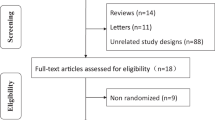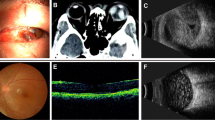Abstract
Purpose
To describe the long-term surgical outcomes of four patients treated for retinal detachment using Seprafilm as a novel technique.
Methods
Retinal breaks in four eyes were covered with Seprafilm using a transvitreal approach after cataract surgery, pars plana vitrectomy, fluid-air exchange, and laser photocoagulation. Neither long-standing gas nor silicone oil was used. The patients were not instructed to maintain a specific head positioning postoperatively.
Results
Successful retinal reattachment was achieved with a single surgery in all four eyes, and none developed proliferative vitreoretinopathy. The mean best-corrected visual acuity preoperatively and 9 years postoperatively were 20/97 and 20/33, respectively. The intraocular pressure increased several days postoperatively that lasted no longer than 2 weeks. Visual field defects either in the inferonasal or inferotemporal quadrant were detected postoperatively. The mean electroretinogram a- and b-wave amplitude ratios of the operated eyes to the fellow eyes were 0.68 and 0.64 preoperatively and 0.87 and 0.92 postoperatively, respectively. The mean corneal endothelial cell density was 2365 cells/mm2 preoperatively and 2592 cells/mm2 postoperatively.
Conclusion
Covering retinal breaks with Seprafilm may promote retinal reattachment without gas tamponade and postoperative head positioning. The visual outcomes 9 years postoperatively showed no apparent adverse effects of intraocular application of Seprafilm.
Similar content being viewed by others
Log in or create a free account to read this content
Gain free access to this article, as well as selected content from this journal and more on nature.com
or
References
Khan MA, Brady CJ, Kaiser RS . Clinical management of proliferative vitreoretinopathy: an update. Retina 2015; 35: 165–175.
Tosi GM, Marigliani D, Romeo N, Toti P . Disease pathways in proliferative vitreoretinopathy: an ongoing challenge. J Cell Physiol 2014; 229: 1577–1583.
Gilbert CE, Grierson I, McLeod D . Retinal patching: a new approach to the management of selected retinal breaks. Eye 1989; 3: 19–26.
Becker JM, Dayton MT, Fazio VW, Beck DE, Stryker SJ, Wexner SD et al. Prevention of postoperative abdominal adhesions by a sodium hyaluronate-based bioresorbable membrane: a prospective, randomized, double-blind multicenter study. J Am Coll Surg 1996; 183: 297–306.
Diamond MP . Reduction of adhesions after uterine myomectomy by Seprafilm membrane (HAL-F): a blinded, prospective, randomized, multicenter clinical study. Seprafilm Adhesion Study Group. Fertil Steril 1996; 66: 904–910.
Sueda J, Sakuma T, Nakamura H, Usumoto N, Okuno T, Arai M et al. In vivo and in vitro feasibility studies of intraocular use of seprafilm to close retinal breaks in bovine and rabbit eyes. Invest Ophthalmol Vis Sci 2006; 47: 1142–1148.
Teruya K, Sueda J, Arai M, Tsurumaru N, Yamakawa R, Hirata A et al. Patching retinal breaks with Seprafilm in experimental rhegmatogenous retinal detachment of rabbit eyes. Eye 2009; 23: 2256–2259.
D'Amico DJ . Clinical practice. Primary retinal detachment. N Engl J Med 2008; 359: 2346–2354.
Tanner V, Minihan M, Williamson TH . Management of inferior retinal breaks during pars plana vitrectomy for retinal detachment. Br J Ophthalmol 2001; 85: 480–482.
Chalam KV, Shah VA . Optics of wide-angle panoramic viewing system-assisted vitreous surgery. Surv Ophthalmol 2004; 49: 437–445.
Harooni M, Freilich JM, Abelson M, Refojo M . Efficacy of hyaluronidase in reducing increases in intraocular pressure related to the use of viscoelastic substances. Arch Ophthalmol 1998; 116: 1218–1221.
Welch JC . Dehydration injury as a possible cause of visual field defect after pars plana vitrectomy for macular hole. Am J Ophthalmol 1997; 124: 698–699.
Yan H, Dhurjon L, Chow DR, Williams D, Chen JC . Visual field defect after pars plana vitrectomy. Ophthalmology 1998; 105: 1612–1616.
McCuen BW, Hida T, Sheta SM . Transvitreal cyanoacrylate retinopexy in the management of complicated retinal detachment. Am J Ophthalmol 1987; 104: 127–132.
Hida T, Sheta SM, Proia AD, McCuen BW . Retinal toxicity of cyanoacrylate tissue adhesive in the rabbit. Retina 1988; 8: 148–153.
Sheta SM, Hida T, McCuen BW . Cyanoacrylate tissue adhesive in the management of recurrent retinal detachment caused by macular hole. Am J Ophthalmol 1990; 109: 28–32.
Hartnett ME, Hirose T . Cyanoacrylate glue in the repair of retinal detachment associated with posterior retinal breaks in infants and children. Retina 1998; 18: 125–129.
Hotta K, Hirakata A, Hida T . The management of retinal detachments associated with choroidal colobomas by vitrectomy with cyanoacrylate retinopexy. Jpn J Ophthalmol 1998; 42: 323–326.
Acknowledgements
This study was funded by Novartis Pharma.
Author information
Authors and Affiliations
Corresponding author
Ethics declarations
Competing interests
The authors declare no conflict of interest.
Additional information
Supplementary Information accompanies this paper on Eye website
Supplementary information
Rights and permissions
About this article
Cite this article
Haruta, M., Arai, M., Sueda, J. et al. Patching retinal breaks with Seprafilm for treating retinal detachments in humans: 9 years of follow-up. Eye 31, 776–780 (2017). https://doi.org/10.1038/eye.2016.329
Received:
Accepted:
Published:
Issue date:
DOI: https://doi.org/10.1038/eye.2016.329
This article is cited by
-
Retinal Tamponades: Current Uses and Future Technologies
Current Ophthalmology Reports (2020)



